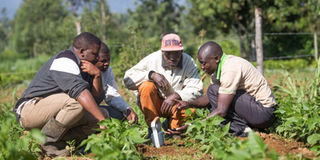Ask your agronomist: The best time to lime soil for better growth of your crops

Farmers test soil in a farm in Meru. Liming the soil is the best way to correct the pH, and make fertiliser use more effective. PHOTO | FILE | NATION MEDIA GROUP
What you need to know:
- Liming the soil is the best way to correct the pH, and make fertiliser use more effective.
- For good liming materials, the purity must be over 80 per cent, the higher the better.
- As a farmer, it is important to ask the supplier to declare these two indices (purity and fineness) for you to know how good the material is.
Q: I am a vegetable farmer in Meru, and I have been told my soil is acidic. Which lime should I apply to correct the soil pH and how?
Liming the soil is the best way to correct the pH, and make fertiliser use more effective. There are different types of liming materials, including Marl, Dolomitic and Calcitic, among others.
These materials are also formulated either as powders, granules or liquids. The various formulations are effective under different conditions, depending on your farming system and how you apply them.
However, the basic principle to remember is that the lime must come into contact with the soil for it to reduce the pH.
Therefore, the most effective formulation to change the soil pH of your farm is that with the greatest surface area covering, that being the powdered formulations.
Liquids are not easily available yet in Kenya.
Quality of lime
The effectiveness of a given liming material, which is described as the Effective Neutralising Value (ENV), is determined by two main factors namely the purity and the fineness of the lime.
Purity is the theoretical acid neutralising capacity of a liming material relative to pure calcium carbonate, which is 100.
For good liming materials, the purity must be over 80 per cent, the higher the better. Purity is expressed as the Calcium Carbonate Equivalent (CCE).
Fineness describes the particle size of the lime, and, therefore, determined by how well the grinding is done in manufacturing process.
The finer the particle size, the better the reactivity of the lime/liming material. Fineness is expressed as the Efficiency Factor (EF).
PERENNIAL CROPS
Therefore, the quality of a given lime should be determined as; Effective Neutralising Value (ENV) = Purity (CCE) X Fineness (EF)
As a farmer, it is important to ask the supplier to declare these two indices (purity and fineness) for you to know how good the material is.
The two determine the quantity of lime per acre that you would apply to correct your soil pH.
Some soil testing laboratories fortunately are able to build these factors in their calculations and recommendations of lime application per acre.
When to apply lime
The best practice is to apply it about two months before planting, to give it time to react in the soil and reduce the pH.
The risk with applying at planting is that lime will react with phosphorous in the planting fertiliser and precipitate as calcium phosphate making some of the phosphorus applied unavailable for plant uptake.
For perennial crops such as coffee, tea, and other tree crops, please apply the lime at establishing the orchard as subsequent application is not very effective as it will only correct the pH in the top, about 20cm deep, leaving the root zone still acidified.
For crop specific fertiliser recommendations, please consult the following agronomists in your area:
Western and Nyanza, Daniel Mui, 0702466343.
Rift Valley, Dennis Nyandaya, 0702466372.
Central, Robert Ngatia, 0702466318.
Vitalis Wafula, Yara East Africa Regional Agronomist




